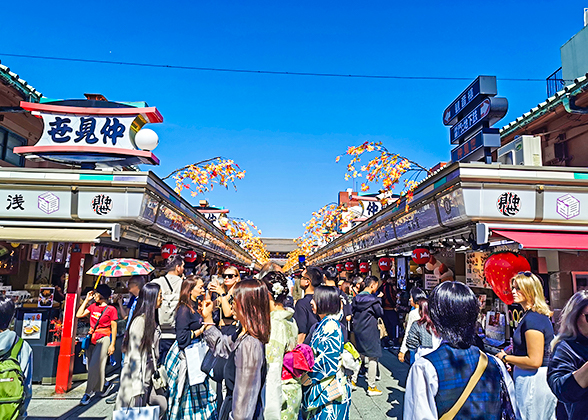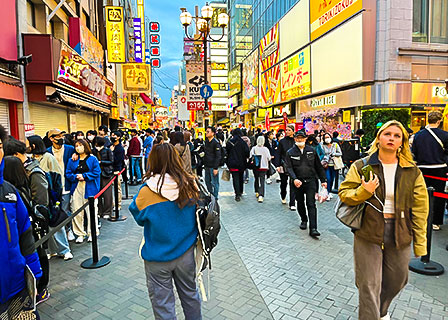Nakamise-dori Street
Kaminarimon Gate & Nakamise-dori Street
History of Nakamise-dori Street
The prosperity of Nakamise-dori Street cannot be separated from Sensoji Temple. After Tokugawa Ieyasu established the Edo shogunate, the number of visitors to Sensoji Temple gradually increased. Some people who cleaned the temple were given the right to open a shop here. During the Edo period, there were many teahouses, toy shops, pastry shops, and souvenir shops. The street was damaged by the earthquake, and the current one was rebuilt after World War II.
|
|
|
Top Things to Do in Nakamise-dori Street
1. Buy the Traditional Crafts as a Gift
There are abundant stores that sell crafts, like fans, masks, dolls, combs, and hair clasps. These objects are cheap and fine and are easy to take for visitors.
Here are some recommended shops:
|
|
|
2. Taste Special Food
The abundant and delicious food attracts countless visitors, and the Ningyo-yaki and rice crackers are not to be missed. Ningyo-yaki is a very famous dim sum in Asakusa, and it is known as the "three famous objects of Sensoji Temple" together with the Kaminarimon Gate and the Five-storied Pagoda. The food tastes sweet and is a kind of bun made of flour, eggs, sugar, and bean paste.
|
|
|
Note: Do not eat food while walking in the street since it is a very impolite behavior in the eyes of the Japanese. You can stand in front of the store and enjoy your food.
3. Take a Rickshaw to Appreciate the Street View

The Rickshaw in Nakamise Shopping Street
|
4. Walk in the Street in a Kimono
A kimono is a kind of Japanese traditional dress, and you can see many people with beautiful kimono walking in Nakamise Shopping Street. Some stores provide kimono rental service, and you can try the kimono you like. Besides, you have the opportunity to see geishas with delicate kimono and makeup in the street.
|
|
|
5. Appreciate the Asakusa Mural Scroll
Asakusa Mural Scroll refers to the paintings on the doors of these stores, about 400 meters (1,312 feet) long. These paintings were finished in 1989 and show the stories about Asakusa. You can appreciate these paintings after the stores are closed or before they are open. In the night, each store will have soft yellow lights lit up, adding the mystery to these paintings.6. Explore New Streets Perpendicular to Nakamise-dori Street

Shinnakamise-Dori Ave
|
Shinnakamise-Dori Ave is a shopping street perpendicular to Nakamise Shopping Street with a glass roof, protecting visitors from rain and wind. The stores here show a modern style. Besides, you can explore Asakusa Yanagi-dori Ave and Dembain-dori Ave, which are the two avenues also perpendicular to Nakamise-dori Street.
Approximate Visit Time
About 0.5-1 Hour. The street will be crowded with tourists after 9 am. The majority of stores will be closed after 5 pm.How to Get to Nakamise-dori Street
1. Take the Tokyo Metro Ginza Line, and get off at Asakusa Station, then get out from Exit2.2. Take the Toei Subway Asakusa Line, and get off at Asakusa Station, then get out from the A4 Exit.
3. Take the TOBU SKYTREE Line, and get off at Asakusa Station, then get out from the Front Exit.
4. Take TSUKUBA EXPRESS and get off at Asakusa Station, then get out from the A2 Exit.
Nearby Attractions to Visit
The Sensoji Temple is the must-visit attraction after exploring Nakamise-dori Street for it is just next to the street. Besides, you can walk to the Sumida River to appreciate the beautiful river view and appreciate the cherry blossoms in Sumida Park in April and May. In addition, the Tokyo Skytree can be seen from the bridge of the Sumida River.
Read more:





